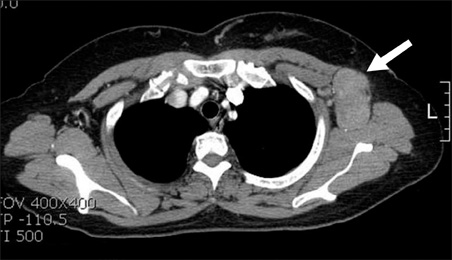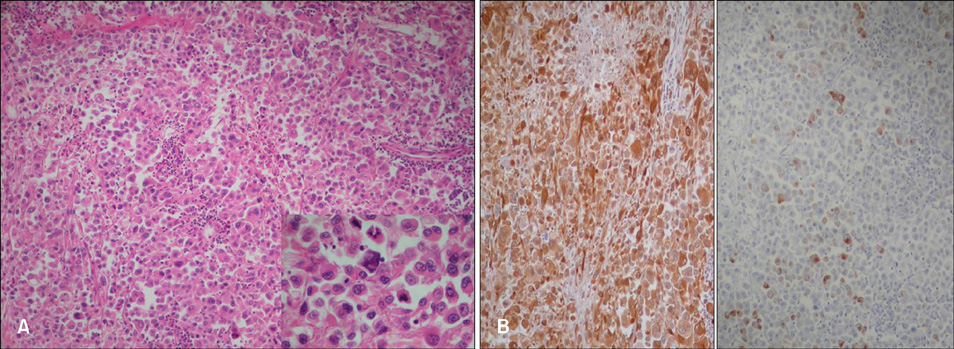Ann Dermatol.
2009 May;21(2):178-181. 10.5021/ad.2009.21.2.178.
Vitiligo-like Depigmentation Associated with Metastatic Melanoma of an Unknown Origin
- Affiliations
-
- 1Department of Dermatology, College of Medicine,The Catholic University of Korea, Seoul, Korea. yymmpark6301@ hotmail.com
- 2Division of Medical Oncology, Department of Internal Medicine, College of Medicine,The Catholic University of Korea, Seoul, Korea.
- KMID: 2219391
- DOI: http://doi.org/10.5021/ad.2009.21.2.178
Abstract
- Although malignant melanoma usually occurs after the diagnosis of vitiligo-like depigmentation, the latter is rarely followed by the former. We herein report on such a case in which recognition of the vitiligo-like depigmentation preceded diagnosing the metastatic melanoma by several months. A 56-year-old woman had first developed vitiligo-like depigmentation on the forehead, eyelids, neck and back 18 months previously and thereafter she detected a hard mass in the left axilla 2 months previously. Based on the histologic findings, the axillary mass was diagnosed as metastatic melanoma. To evaluate the primary tumor focus, thorough examinations that included PET-CT, bone scan and sigmoidoscopy were performed, but we couldn`t find any the original primary tumor. Our case suggests that the vitiligo-like depigmentation could be a sign that heralds metastatic melanoma.
Figure
Reference
-
1. Ortonne JP, Gauthier Y, Guillet G, Gauthier O. Hypomelanosis of the skin and malignant melanoma. Ann Dermatol Venereol. 1978. 105:1043–1052.2. Duhra P, Ilchyshyn A. Prolonged survival in metastatic malignant melanoma associated with vitiligo. Clin Exp Dermatol. 1991. 16:303–305.
Article3. Nordlund JJ, Kirkwood JM, Forget BM, Milton G, Albert DM, Lerner AB. Vitiligo in patients with metastatic melanoma: a good prognostic sign. J Am Acad Dermatol. 1983. 9:689–696.
Article4. Kiecker F, Hofmann M, Sterry W, Trefzer U. Vitiligo-like depigmentation as a presenting sign of metastatic melanoma. J Eur Acad Dermatol Venereol. 2006. 20:1135–1137.
Article5. Berd D, Mastrangelo MJ, Lattime E, Sato T, Maguire HC Jr. Melanoma and vitiligo: immunology's Grecian urn. Cancer Immunol Immunother. 1996. 42:263–267.
Article6. Schallreuter KU, Levenig C, Berger J. Vitiligo and cutaneous melanoma. A case study. Dermatologica. 1991. 183:239–245.7. Merimsky O, Shoenfeld Y, Yecheskel G, Chaitchik S, Azizi E, Fishman P. Vitiligo- and melanoma-associated hypopigmentation: a similar appearance but a different mechanism. Cancer Immunol Immunother. 1994. 38:411–416.
Article8. Arpaia N, Cassano N, Vena GA. Regressing cutaneous malignant melanoma and vitiligo-like depigmentation. Int J Dermatol. 2006. 45:952–956.
Article9. Cui J, Bystryn JC. Melanoma and vitiligo are associated with antibody responses to similar antigens on pigment cells. Arch Dermatol. 1995. 131:314–318.
Article10. Yee C, Thompson JA, Roche P, Byrd DR, Lee PP, Piepkorn M, et al. Melanocyte destruction after antigen-specific immunotherapy of melanoma: direct evidence of t cell-mediated vitiligo. J Exp Med. 2000. 192:1637–1644.11. Le Gal FA, Avril MF, Bosq J, Lefebvre P, Deschemin JC, Andrieu M, et al. Direct evidence to support the role of antigen-specific CD8(+) T cells in melanoma-associated vitiligo. J Invest Dermatol. 2001. 117:1464–1470.
Article12. Hornung MO, Krementz ET. Specific tissue and tumor responses of chimpanzees following immunization against human melanoma. Surgery. 1974. 75:477–486.13. Cui J, Chen D, Misfeldt ML, Swinfard RW, Bystryn JC. Antimelanoma antibodies in swine with spontaneously regressing melanoma. Pigment Cell Res. 1995. 8:60–63.
Article14. Ohsie SJ, Sarantopoulos GP, Cochran AJ, Binder SW. Immunohistochemical characteristics of melanoma. J Cutan Pathol. 2008. 35:433–444.
Article15. Bystryn JC, Rigel D, Friedman RJ, Kopf A. Prognostic significance of hypopigmentation in malignant melanoma. Arch Dermatol. 1987. 123:1053–1055.
Article16. Koh HK, Sober AJ, Nakagawa H, Albert DM, Mihm MC, Fitzpatrick TB. Malignant melanoma and vitiligo-like leukoderma: an electron microscopic study. J Am Acad Dermatol. 1983. 9:696–708.
Article
- Full Text Links
- Actions
-
Cited
- CITED
-
- Close
- Share
- Similar articles
-
- Depigmentation Therapy with Monobenzyl Ether of Hydroquinone in a Patient with Vitiligo Universalis
- Two Cases of Congenital Giant Melanocytic Nevus (CGMN) with Vitiligo
- Malignant Melanoma of Unknown Primary Origin Presenting as Cardiac Metastasis
- Development of Vitiligo-Like Depigmentation after Treatment of Lentigo Maligna Melanoma with 5% Imiquimod Cream
- Halo Congenital Nevus Followed by Periocular Vitiligo




